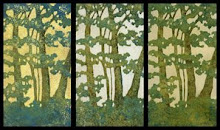 So, a few months ago I had about an hour to pop into a workshop at the Dayton Printmakers Co-Op by Sinclair printmaking professor Kevin Harris for a quick lesson on waterless lithography. For those unfamiliar with the process, it goes something like this... you draw on a grained aluminum litho plate, cover the drawing with a thin layer of silicone, wash off the drawing and voila, you are left with a plate which repels rubber based ink anywhere there is silicone. You can also use the process by transferring a Xerox copy to the plate with lacquer thinner or acetate and then going through the same steps. Sounds pretty simple, eh?
So, a few months ago I had about an hour to pop into a workshop at the Dayton Printmakers Co-Op by Sinclair printmaking professor Kevin Harris for a quick lesson on waterless lithography. For those unfamiliar with the process, it goes something like this... you draw on a grained aluminum litho plate, cover the drawing with a thin layer of silicone, wash off the drawing and voila, you are left with a plate which repels rubber based ink anywhere there is silicone. You can also use the process by transferring a Xerox copy to the plate with lacquer thinner or acetate and then going through the same steps. Sounds pretty simple, eh?It's not that complicated of a process, but of course there are some variables and things that can go wrong and things you can spend a lot of time correcting. Otherwise it would be something different than printmaking. You are supposed to be able to draw with any water based media so I tried about everything I had around the house, from watercolor pencils to some mixture of Akua Kolor ink and modifiers of who knows what kind, to sharpies and gel pens, which are also supposed to work. I spent a lot of time drawing. Note to self: Always do a small test before investing a lot of time drawing! Needless to say, I wasted a few plates and drawings and hours, but I did get to enjoy the drawing part of it. And I got smart and started scanning in my drawings so in case I ruin the one on the plate I can still try the Xerox method, even though I'm resistant to using anything that is a "reproduction." I think I'm afraid that once I go down that road I'll start going through the thousands of photographs that live on this machine and start trying to print those instead of coming up with new things.
Anyway, I discovered that there's something about the way ink flows onto these aluminum plates from a calligraphy pen, those kind you dip into the ink, that's a little bit magical. There's something about the smoothness of it and the way it clings to the surface that's graceful and sexy and it's hard to resist. And it's perfect for drawing tree limbs. There's also a randomness to the prints that I really like. I keep ending up losing some of the fine detail in the silicone process, as this is one of the variables that it's difficult to get just right. You get it on a little to thick or too thin and then you can't wash away the drawing or you wash off too much. But in a way I like that. It gives a neat and tidy drawing a little edginess, or something like that, and the random stuff can happen with in the inking is also pretty appealing to me.
And I get to play with ink. I've been inking them up with a rubber based black VanSon ink and then applying Akua Kolor over the plate. It's a trial and error process, as it's difficult to get the Akua Kolor just the right consistency to adhere to the silicone...it naturally wants to bead up. Thin layers brushed on and feathered out very gently seem to work best. I can't get any of the softness I like about my woodcuts with the process, and believe me I've tried and failed, but there's something stark and graphic about the end product that I like. And wow, do I enjoy the drawing part.




